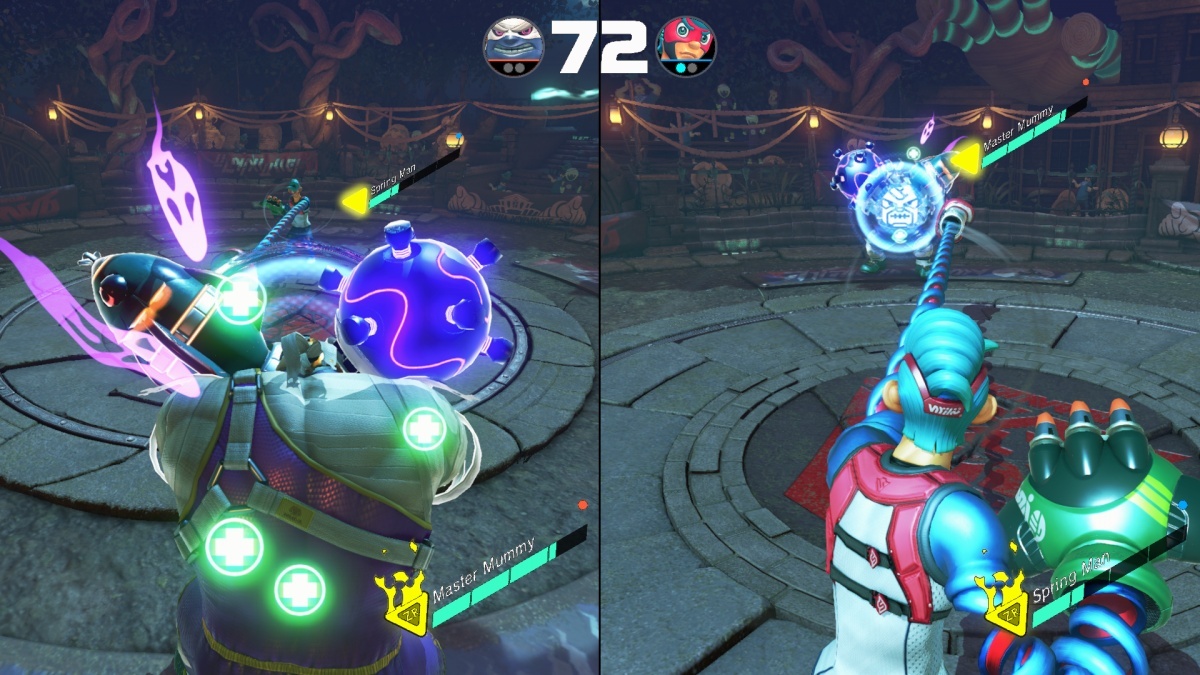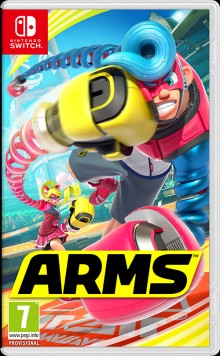Arms (Nintendo Switch) Review
By Tomas Barry  15.06.2017
15.06.2017

With slick and in-depth motion-controls, a unique roster of characters and an intense brand of competitive multiplayer mayhem, the spiritual successor to Punch-Out!! - ARMS - looks to come out swinging on Switch. After a lengthy reveal process and numerous hands-on events featuring the intriguingly exciting and colourful title, which included the recent Global Testpunch trial for regular folk to give it a try, the latest Nintendo Switch title is finally here. Is ARMS everything Nintendo had hoped it would be?
Nintendo certainly isn't a stranger to motion controls, nor has it historically been afraid of centring its games on such apparatus. Take the simple and extraordinarily intuitive Wii Sports, packaged with the Wii when it initially launched. The title underlined the potential and the appeal of the motion technology remarkably well, highlighting what could be done whilst remaining accessible and straightforward. On the other hand, by the end of the system's lifespan, even Nintendo's first-party games, such as The Legend of Zelda: Skyward Sword, hardly represented the pinnacle of, nor even a notable development for, motion controls, despite that being one of the dominant themes of that platform. It's been an up and down affair, no pun intended.
These days, motion controls are usually incorporated in more subtle and minor ways, such as the way it enables physical aiming when using a bow and arrow in The Legend of Zelda: Breath of the Wild. Unless tied into a larger VR experience, motion input rarely seems to be a central component in many modern game experiences, let alone in a potential new franchise. While ARMS does make the very practical compromise of allowing players to use a variety of control methods (an issue that will be covered later), there's certainly no doubt that Nintendo is pushing the Joy-Con motion control method as the main way to play. By putting this element at the forefront, ARMS puts the onus on itself to prove Nintendo can develop a more complex, precise and cohesive motion-based experience than those typically found on the Wii.

Despite the very thorough and thoughtful interactive tutorials that first-time players are presented with, ARMS feels a little jarring and frustrating during the initial hour, while the motion components and combat principles sink in. The core motion inputs are indeed simple and intuitive, but there will inevitably be some degree of adjusting to do, even if it is just getting used to holding the Joy-Con in a slightly new position. Grasping them upright in each hand, with the thumbs resting on top of the shoulder buttons, players can simply imitate the action of a punch for that to translate to the in-game action. This feels very satisfying, especially thanks to the use of the HD Rumble, which helps to reaffirm the sense of a real physical battle. Punches can be modified with curves by changing the striking angle of the Joy-Con, which not only feels great but also seems to be very well appropriated. Each modified swing appears to be accurately translated, but never so precisely that being accurate is impossible, nor so simplistically that it feels as if skill is not required.
Elsewhere, in terms of controls, holding the Joy-Con inwards toward each other initiates a block, while basic player movement is achieved by pointing both in the direction desired. The latter does, admittedly, feel a little slow and cumbersome, and perhaps even unnecessary, considering that alternative control methods use the traditional methods for movement. However, this becomes less of an issue over time, since the dodging and jump mechanics, which are mapped to the left and right shoulder buttons, respectively, quickly become quite integral aspects of smart adjustments.
Unfortunately, some events and match modes that require precise positioning do show up the motion controls. Firstly, it can be tough to position the fighter exactly as desired, even if there is time. Secondly, having to momentarily over-fixate on this aspect of control creates a slight disconnect between player and the action overall, which seems a shame. Thankfully, the best moments of ARMS never get disrupted by this niggling issue, since it doesn't usually occur when the opponent is the focus. Perhaps because half the movement is reactive, in a sense, which is quite different to strafing up and down a line to hit specific targets. That's the aim of one such mode, skillshot, which was not a personal highlight, although it did promote and reveal the complexity involved in timing and shaping punches using the curve modifier.

ARMS brings a surprisingly decent amount of game-mode variety on top of standard and team fights, but, just like skillshot, the other distractions from traditional fighting action seem a little underwhelming and rather like padding in many cases. V-Ball sees foes batting a volleyball rigged with explosives at one another - should it hit the ground, boom! This could have been a standout mode, but unfortunately it's too difficult to dig the ball out during heated moments, leading more to frustration than to genuine moments of joy. The less seriously this one is treated, and the more people involved, the better the experience. Hoops is a somewhat simplistic in premise, as points are scored by grappling the opponent and dunking them through a nearby basketball net. This is suitably wacky, but not nearly as much fun as it sounds, since it ends up being one of the more thoughtless modes. 1 on 100 offers a single player the challenge of battling a range of enemies that multiply and increase in difficulty as things progress, which could be quite useful for lone players when online multiplayer isn't possible. Grand Prix mode is a selection of these trimmings, with some additional surprises. It's another piece of content that lone individuals will be thankful for but, ultimately, it's hardly where the beating heart of the game resides.
That, undoubtedly, would be multiplayer, both online and offline. It's clear that playing with others, whether they are in your living room or on the other side of the world, is how ARMS aims to sustain itself. Much like Splatoon (another new IP from Nintendo in recent years), outside of that domain things are a little bare, but the competitive multiplayer side of things more than makes up for that. In terms of local multiplayer, Nintendo has proven itself time and time again, but here it's certainly refreshing to be presented with such a new brand of quirkiness and multiplayer that feels tremendously accessible yet also retains real depth.
There's quite a careful balance in fighting styles struck between the ten characters, all of which seem quite distinct, and all with their own quirks. Each fighter comes with their own advantages and trade-offs but, on top of this, players can choose from a range of weapons for their character to don on each arm, from traditional gloves to boomerangs and everything in-between. The potential for different combinations and the fun had by simply experimenting and discovering, really does add a sense of finesse and polish to the combat, overall. While not every weapon choice offers a wholesomely unique tactical advantage, each one behaves differently, so that thoughtful switching often leads to a switch in dynamic. This is impressive, since it's not easy to implement this level of strategy in a fast-paced, motion-based, animated boxing title. All of these gameplay details shine in multiplayer, where gamers can truly get stuck into the one-on-one or team-based action, which is where the serious fun is.

There are various ways in which the fine details shine, such as getting to know a friend's strategy over a series of split-screen, local multiplayer duels. There's a great slow burn tactical dynamic in play in such conditions. One person will strike a good combination of gloves, something comfortable and manageable on the one hand, and perhaps a defensive ploy on the other. The other walks away from said session with something to think about; then, the next time the friends meet, the defeated player is sporting a totally different setup, leaving last session's victor lost and vulnerable. Even if you can't physically out-wit the opponent, there may be a more thoughtful approach available via possibilities of this kind.
Online, it's more a case of shape-up or be crushed when it comes to ranked matches. Once players start to get matched with more challenging ones, expect to be pummelled if a strategy really does fall to pieces - someone with better timing and more experience of the animations, moves and how to appropriately react to each situation will also be able to identify and take advantage of a faltering approach. In this sense, while ARMS may look like quite a happy-go-lucky and simplistic arcade experience, there's far more depth here than some might expect. It's very easy to feel helpless and even a little foolish, particularly if using the motion controls, as there's no hiding how frustrating it is when nothing comes off. On the other hand, training will yield actual improvements, and this rather harsh and uncompromising edge makes a win much more satisfying, too.
Elsewhere, in terms of online content, there's a party mode that regularly cycles through all the game modes, whilst mixing up the lobbies. The presentation and functionality here is great. The interface is very clean and simple, offering a clear view of other players present and the events going on and being prepared, while it's also very easy to switch weapons and characters on the fly, without leaving the lobby. All of this flexibility indicates Nintendo does have grander intentions in this department moving forward, which is very encouraging indeed.

Cubed3 Rating
Very Good - Bronze Award

Overall, ARMS is delightfully quirky, surprisingly deep and, most importantly, strikingly self-confident. Whilst its vibrant and over-the-top aesthetic might have some expecting a shallow and simplistic experience, persevering with and embracing the game's sharp initial learning curve reveals a strong-willed and very detailed gameplay core. Nintendo made the right choice in highlighting the motion controls, which is by far the best way to play. Thankfully, it also showed a more practical side in allowing room for the other traditional control methods, too - an additional set of Joy-Con is expensive, after all. As with the original Splatoon, it is slightly disappointing that single-player content seems like an after-thought to the multiplayer. However, considering how that game was supported and expanded during its life-span, something Nintendo is likewise committed to here, there's no doubt there's plenty more to come from this instalment, and (presumably) from this refreshing new series.
Comments
Comments are currently disabled

 Sign In
Sign In Game Details
Game Details
 Out now
Out now  Out now
Out now  Out now
Out now  Out now
Out now  Subscribe to this topic
Subscribe to this topic Features
Features





 Top
Top

